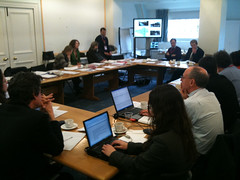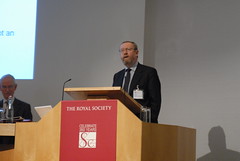 A successful day was enjoyed by all participants (ECSFDI staff and research scientists). This was helped along by glorious sunshine.
A successful day was enjoyed by all participants (ECSFDI staff and research scientists). This was helped along by glorious sunshine. Key messages from the day:
1) the need for robust guidance for on the ground staff is critical, 2) we require better ways to get the evidence to farmers to influence behavioural change (currently it is still coming from too many conflicting sources, often commercially funded), 3) simple but scientifically based rules of thumb are vital to help transfer knowledge to farmers and other land managers e.g. 1,000,000 people = 100 sheep in terms of approximate loading of FIOs to the catchment (Dave Kay, CREH), 4) we must learn from existing studies in the UK and around the world (in Ireland establishing the catchment programme has been a great success, but it must continue past 2011 to detect change in water quality due to reducing soil P status and changing farmer's behaviours; in addition they only used catchments with 100% buy in from farmers), 5) we need frameworks that can be used to understand the systems being studied e.g. a farm and be utilised to communicate not only between research scientists, but also between scientists and operational staff and with policy makers (Phil Jordan's (Teagasc) use of the Haygarth et al source-mobilization-delivery-impact continuum to link with environmental standards is an important advance as is the ecosystem service framework), 6) we need more holistic (chemical, biological and physical hazards and biodiversity) scientific studies on the effectiveness of mitigation methods e.g. riparian buffers for multiple functions e.g. diffuse pollution of water, GHG emissions, biodiversity and flood risk (good examples of this are Rich Brazier's research on the Holnicote Estate on Exmoor that is funded by Defra and the National Trust and the multi-agency funded Demonstration Test Catchments) , 7) and we really need to assess if certain mitigation methods are working as expected e.g. subsurface losses from pond systems in England and Wales (these are smaller water bodies than those in Ireland and tend not to have a synthetic liner-as this doubles the cost (Dave Kay)), 8) there is still a dearth of long term data on the effectiveness of many mitigation methods (a classic example from Scotland is the issue of up keep of fencing water courses; fencing of watercourses is very effective for reducing FIO loads (30% livestock exclusion ~ 60-80% reduction- Dave Kay) and last but not least 9) there is a need for robust quantitative models for source apportionment and the effectiveness of mitigation methods.

